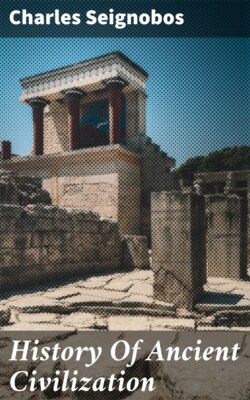Читать книгу History Of Ancient Civilization - Charles Seignobos - Страница 21
На сайте Литреса книга снята с продажи.
THE EGYPTIANS
ОглавлениеTable of Contents
The Land of Egypt.—Egypt is only the valley of the Nile, a narrow strip of fertile soil stretching along both banks of the stream and shut in by mountains on either side, somewhat over 700[6] miles in length and 15 in width. Where the hills fall away, the Delta begins, a vast plain cut by the arms of the Nile and by canals. As Herodotus says, Egypt is wholly the gift of the Nile.
The Nile.—Every year at the summer solstice the Nile, swollen by the melted snows of Abyssinia, overflows the parched soil of Egypt. It rises to a height of twenty-six or twenty-seven feet, sometimes even to thirty-three feet.[7] The whole country becomes a lake from which the villages, built on eminences, emerge like little islands. The water recedes in September; by December it has returned to its proper channel. Everywhere has been left a fertile, alluvial bed which serves the purpose of fertilization. On the softened earth the peasant sows his crop with almost no labor. The Nile, then, brings both water and soil to Egypt; if the river should fail, Egypt would revert, like the land on either side of it, to a desert of sterile sand where the rain never falls. The Egyptians are conscious of their debt to their stream. A song in its honor runs as follows: "Greeting to thee, O Nile, who hast revealed thyself throughout the land, who comest in peace to give life to Egypt. Does it rise? The land is filled with joy, every heart exults, every being receives its food, every mouth is full. It brings bounties that are full of delight, it creates all good things, it makes the grass to spring up for the beasts."
Fertility of the Country.—Egypt is truly an oasis in the midst of the desert of Africa. It produces in abundance wheat, beans, lentils, and all leguminous foods; palms rear themselves in forests. On the pastures irrigated by the Nile graze herds of cattle and goats, and flocks of geese. With a territory hardly equal to that of Belgium, Egypt still supports 5,500,000 inhabitants. No country in Europe is so thickly populated, and Egypt in antiquity was more densely thronged than it is today.
The Accounts of Herodotus.—Egypt was better known to the Greeks than the rest of the Orient. Herodotus had visited it in the fifth century B.C. He describes in his History the inundations of the Nile, the manners, costume, and religion of the people; he recounts events of their history and tales which his guides had told him. Diodorus and Strabo also speak of Egypt. But all had seen the country in its decadence and had no knowledge of the ancient Egyptians.
Champollion.—The French expedition to Egypt (1798–1801) opened the country to scholars. They made a close examination of the Pyramids and ruins of Thebes, and collected drawings and inscriptions. But no one could decipher the hieroglyphs, the Egyptian writing. It was an erroneous impression that every sign in this writing must each represent a word. In 1821 a French scholar, Champollion, experimented with another system. An official had reported that there was an inscription at Rosetta in three forms of writing—parallel with the hieroglyphs was a translation in Greek. The name of King Ptolemy, was surrounded with a cartouche.[8] Champollion succeeded in finding in this name the letters P, T, O, L, M, I, S. Comparing these with other names of kings similarly enclosed, he found the whole alphabet. He then read the hieroglyphs and found that they were written in a language like the Coptic, the language spoken in Egypt at the time of the Romans, and which was already known to scholars.
Egyptologists.—Since Champollion, many scholars have travelled over Egypt and have ransacked it thoroughly. We call these students Egyptologists, and they are to be found in every country of Europe. A French Egyptologist, Mariette (1821–1881), made some excavations for the Viceroy of Egypt and created the museum of Boulak. France has established in Cairo a school of Egyptology, directed by Maspero.
Discoveries.—Not every country yields such rich discoveries as does Egypt. The Egyptians constructed their tombs like houses, and laid in them objects of every kind for the use of the dead—furniture, garments, arms, and edibles. The whole country was filled with tombs similarly furnished. Under this extraordinarily dry climate everything has been preserved; objects come to light intact after a burial of 4,000 or 5,000 years. No people of antiquity have left so many traces of themselves as the Egyptians; none is better known to us.
